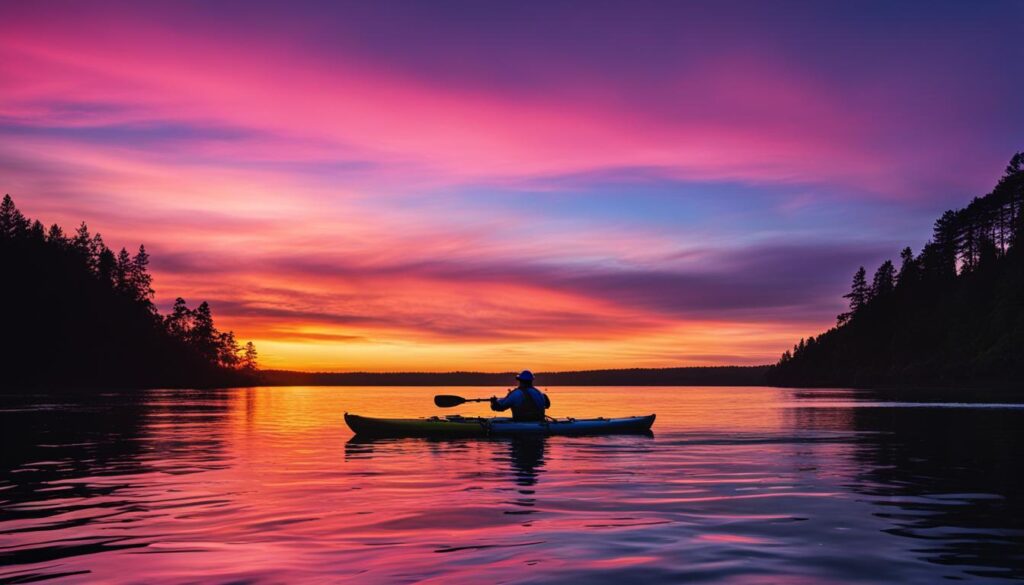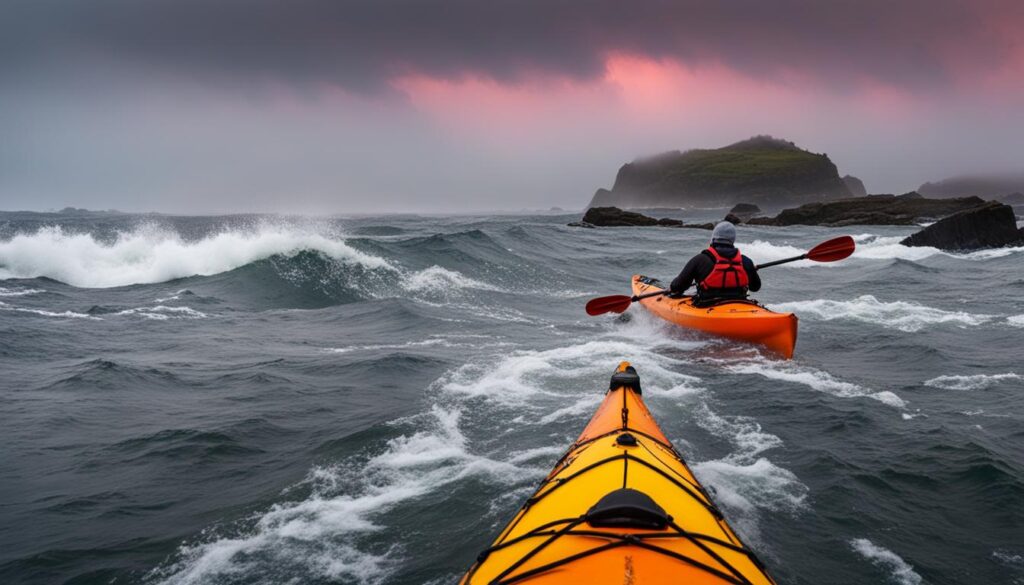Sea kayaking has become increasingly popular among adventurous paddlers and expeditioners. To safely navigate open waters and enhance the overall experience, it is important to master a set of essential skills. These skills include learning how to make a bilge pump for emptying a flooded cockpit, staying visible on the water, scouting ocean surf, constructing a tow line, performing a sea kayak scramble self-rescue, understanding marine VHF radio use, and re-entering and rolling your kayak. These skills ensure safety, comfort, and the ability to navigate effectively while sea kayaking.
Key Takeaways:
- Master essential open water paddling skills for a safe and enjoyable experience.
- Learn how to make a bilge pump to effectively remove water from your kayak.
- Maintain visibility on the water by choosing the right clothing and using high-visibility gear.
- Scout ocean surf to choose the right beach for launching or landing your kayak in coastal areas.
- By mastering these skills, you can tackle advanced open water kayak expeditions with confidence.
Learn how to make a bilge pump
When it comes to open water paddling, knowing how to make a bilge pump is an essential skill that every sea kayaker should have. A bilge pump is used to empty a flooded cockpit, ensuring that you can stay safe and comfortable even when you’re far from home. There are different options available for bilge pumps, including foot-operated or electric ones. But did you know that you can also build your own battery-operated kayak bilge pump using easily available parts? This DIY approach not only saves money but also allows you to customize your bilge pump according to your specific needs.
Having a bilge pump in your sea kayaking equipment is crucial for several reasons. Firstly, it allows you to quickly and efficiently remove water from your kayak, preventing it from becoming unstable or difficult to maneuver. Secondly, a bilge pump can help you stay afloat in case of an emergency, giving you more time to safely reach shore or call for assistance. And finally, a bilge pump enhances your overall sea kayaking experience by providing peace of mind and allowing you to focus on enjoying the beauty of the open water.
“A bilge pump is like an insurance policy for sea kayakers. It’s something you hope you never have to use, but having it gives you confidence and peace of mind.”
Whether you choose a pre-made bilge pump or decide to build your own, make sure it is easily accessible while paddling. A bilge pump should be within arm’s reach, either secured to your kayak or stored in a handy location. Remember, being prepared is the key to a successful and safe sea kayaking adventure!
Table: Pros and Cons of Different Bilge Pump Options
| Bilge Pump Option | Pros | Cons |
|---|---|---|
| Foot-Operated Bilge Pump | – Provides hands-free operation – Easy to use – Can be securely mounted to the kayak |
– Requires additional foot space in the cockpit – Limited pumping capacity |
| Electric Bilge Pump | – Offers high pumping capacity – Requires minimal physical effort – Can be operated with a switch or button |
– Relies on battery power – Can be more expensive than other options – May require installation and wiring |
| DIY Battery-Operated Bilge Pump | – Cost-effective – Customizable according to your preferences – Can be easily assembled with readily available parts |
– Requires basic electrical knowledge and skills – May not have the same pumping capacity as pre-made options – DIY parts may not be as durable as commercial ones |
As you can see, each bilge pump option has its own advantages and disadvantages. Consider your specific needs, budget, and level of expertise before making a decision. Regardless of the option you choose, having a bilge pump as part of your sea kayaking equipment is an absolute must for any open water adventure!
Stay Visible on the Water
Maintaining visibility on the water is essential for the safety of sea kayakers. As a sea kayaker, you need to have a high-visibility mindset and take proactive measures to ensure that other watercraft can easily spot you. One of the first steps you can take is to choose the right paddling clothes. Opt for bright, neon colors that are easily distinguishable from the surrounding environment. This not only makes you more visible but also adds a touch of personal style to your kayaking adventures.
In addition to bright clothing, consider using accessories that enhance your visibility on the water. Attach reflective tape or stickers to your paddle or kayak to increase your visibility, especially during low-light conditions. Using a brightly colored paddle can also make a significant difference in your visibility. These small but effective measures can greatly reduce the risk of accidents and ensure a safer sea kayaking experience.
Remember, visibility is especially crucial when paddling in foggy or hazy conditions. These weather conditions can significantly impair visibility and increase the chances of collisions with other watercraft. By staying visible on the water, you not only protect yourself but also contribute to the overall safety of everyone sharing the water.
Ultimately, maintaining visibility requires a combination of the right clothing, accessories, and a high-visibility mindset. By embracing these practices, you can enjoy your sea kayaking adventures with confidence, knowing that you are doing everything possible to stay safe and visible on the water.

Benefits of Staying Visible on the Water
- Reduces the risk of accidents and collisions with other watercraft
- Enhances overall safety for both you and other kayakers
- Allows for better communication and coordination with other boaters
- Increases your confidence and peace of mind while sea kayaking
Scout Ocean Surf in Your Kayak
When venturing into coastal areas, sea kayakers often encounter the challenge of launching or landing their kayaks in a surf zone. This dynamic and powerful surf can offer both exhilarating opportunities and potential dangers. Therefore, it is essential to develop the skill of scouting ocean surf to ensure a safe and enjoyable experience.
Scouting ocean surf involves assessing the beaches and determining the best location for launching or landing, considering the prevailing conditions. Factors to consider include wave height, direction, and frequency, as well as the presence of rocks or other hazards. By carefully observing the surf zone and understanding its behavior, you can make informed decisions and choose a safe entry or exit point.
It’s important to approach ocean surf scouting with caution and patience. Take the time to study the waves from different angles and distances. Look for patterns and identify areas where the waves break with less intensity or create a more predictable path. By doing so, you can increase your chances of a successful launch or landing and minimize the risks associated with surf zone paddling.
Tips for Ocean Surf Scouting:
- Observe the surf zone from different vantage points to gain a comprehensive understanding of the conditions.
- Identify areas with lower wave intensity or more predictable breaking patterns.
- Take note of any hazards, such as rocks or strong currents, that may impact your navigation.
- Consider the timing of your launch or landing to coincide with lulls in wave activity.
- Consult local knowledge or experienced kayakers familiar with the area for additional insights and recommendations.
Remember, ocean surf scouting is an essential skill for paddling in coastal areas. By honing this skill, you can navigate the surf zone with confidence, ensuring a safe and enjoyable sea kayaking experience.

| Advantages of Ocean Surf Scouting | Disadvantages of Insufficient Scouting |
|---|---|
| Enhanced safety during launching and landing | Increased risk of capsizing or collision in turbulent surf |
| Ability to choose the safest entry or exit point | Potential damage to the kayak from unexpected hazards |
| Greater confidence and control while navigating the surf zone | Difficulty in re-entering the kayak if capsized in challenging conditions |
| Opportunity for enjoyable surf play and riding waves | Potential injuries caused by improper landing techniques |
Conclusion
Mastering the essential open water paddling skills is crucial for sea kayakers who aim to navigate open waters with confidence and safety. These skills, including making a bilge pump, staying visible on the water, scouting ocean surf, constructing a tow line, performing a sea kayak scramble self-rescue, understanding marine VHF radio use, and re-entering and rolling your kayak, empower you to elevate your open water kayaking abilities.
By honing these skills, you not only enhance safety but also gain the expertise needed to undertake advanced open water kayak expeditions. As you master open sea kayaking, you can explore vast open water environments with confidence and tackle challenging conditions with ease.
So, take the time to practice and perfect these open water paddling skills. Invest in your training and experience the rewards of becoming a skilled and capable sea kayaker. With the right skills, you can conquer any open water challenge and embark on unforgettable adventures in the world of advanced open water kayaking.
FAQ
What is the most crucial skill for open water paddlers?
Knowing how to make a bilge pump.
Why is a bilge pump important for sea kayakers?
It allows you to effectively empty the flooded cockpit when you are far from home.
What are the options for bilge pumps?
There are foot-operated, electric, and DIY battery-operated options available.
Why is maintaining visibility on the water important?
Sea kayaks are relatively small, so it’s crucial to take measures to ensure visibility and reduce the risk of accidents.
How can I improve my visibility while sea kayaking?
Choose bright paddling clothes, use high-visibility gear, and consider the colors of your paddle and accessories.
What is the challenge of launching or landing in a surf zone?
Surf can be dynamic and powerful, so it’s important to have the skill of scouting ocean surf to choose safe landing spots.
How can I assess beaches and determine safe landing spots?
Learning how to scout ocean surf and understand the conditions will help you make informed decisions.
Why are these skills essential for sea kayakers?
Mastering these skills enhances safety, allows for effective navigation, and enables more advanced open water kayak expeditions.





